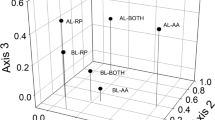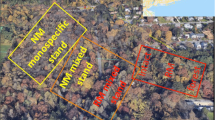Abstract
Habitat invasibility has been found to increase dramatically following the alteration of ecosystem properties by a nonnative species. Robinia pseudoacacia, black locust, is a nitrogen-fixing, clonal tree species that aggressively invades open habitats and expands outside of plantations worldwide. Robinia pseudoacacia stands in Cape Cod National Seashore were particularly susceptible to a hurricane in 1991 that caused widespread blowdown and a dramatic reduction in Robinia in some stands. We used this change to investigate the lasting ecological effects of this nonnative species on this upland coastal ecosystem. We established replicate clusters of 20 × 20 m field plots within 50 m of each other that contained native pitch pine (Pinus rigida) and oak (Quercus velutina, Q. alba) forest, living Robinia stands, and stands in which Robinia was eliminated or reduced to less than 5 % cover by the hurricane. Net nitrification and extractable soil nitrate concentration differed significantly between stand types, in the order Robinia > former Robinia > pine-oak. Nonnative species cover differed significantly between each stand type, in the order Robinia > former Robinia > pine-oak. Invasion of Robinia pseudoacacia increased soil net nitrification and nitrogen availability and precipitated a change in forest species composition that favored nonnative species. The presence of elevated soil nitrogen and nonnative species persisted at least 14 years after the removal of the original invading tree species, suggesting that the invasion of a tree species left a legacy of altered soil biogeochemistry, a higher number of nonnative species, and greater nonnative species cover.




Similar content being viewed by others
References
Aber JD, Nadelhoffer KJ, Steudler P, Melillo JM (1989) Nitrogen saturation in northern forest ecosystems. Bioscience 39:378–386
Adler PB (1998) Understory succession following a dieback of Myrica faya in Hawai’i Volcanoes National Park. Pac Sci 52:69–78
Bellemare J, Motzkin G, Foster DR (2002) Legacies of the agricultural past in the forested present: an assessment of historical land-use effects on rich mesic forests. J Biogeogr 29:1401–1420
Boring LR, Swank WT (1984) The role of black locust (Robinia pseudoacacia) in forest succession. J Ecol 72:749–766
Bormann BT et al (1993) Rapid N2 fixation in pines, alder, and locust—evidence from the sandbox ecosystem study. Ecology 74:583–598
Bowen JL, Valiela I (2001) Historical changes in atmospheric nitrogen deposition to Cape Cod, Massachusetts, USA. Atmos Environ 35:1039–1051
Callaway RM, Thelen GC, Rodriguez A, Holben WE (2004) Soil biota and exotic plant invasion. Nature 427:731–733
Cambardella C, Elliot E (1994) Carbon and nitrogen dynamics of soil organic matter fractions from cultivated grassland soils. Soil Sci Am J 58:122–130
Carlton GC, Bazzaz FA (1998) Resource congruence and forest regeneration following an experimental hurricane blowdown. Ecology 79:1305–1319
Compton JE, Boone RD (2000) Long-term impacts of agriculture on soil carbon and nitrogen in New England forests. Ecology 81:2314–2330
Compton JE, Boone RD, Motzkin G, Foster DR (1998) Soil carbon and nitrogen in a pine-oak sand plain in central Massachusetts: role of vegetation and land-use history. Oecologia 116:536–542
Corbin JD, D’Antonio CM (2004) Effects of exotic species on soil nitrogen cycling: implications for restoration. Weed Technol 18:1464–1467
Cronk QCB, Fuller JL (1995) Plant invaders: the threat to natural ecosystems, 1st edn. Chapman and Hall, London
Cuno JB (1919) Utilization of black locust. United States Department of Agriculture, Washington, DC
D’Antonio CM, Vitousek PM (1992) Biological invasions by exotic grasses, the grass fire cycle, and global change. Annu Rev Ecol Syst 23:63–87
Daehler CC (1998) The taxonomic distribution of invasive angiosperm plants: ecological insights and comparison to agricultural weeds. Biol Conserv 84:167–180
Di Tomaso JM (1998) Impact, biology, and ecology of saltcedar (Tamarix spp.) in the southwestern United States. Weed Technol 12:326–336
Dupouey JL, Dambrine E, Laffite JD, Moares C (2002) Irreversible impact of past land use on forest soils and biodiversity. Ecology 83:2978–2984
Eberhardt RW, Foster DR, Motzkin G, Hall B (2003) Conservation of changing landscapes: vegetation and land-use history of Cape Cod National Seashore. Ecol Appl 13:68–84
Ehrenfeld JG (2003) Effects of exotic plant invasions on soil nutrient cycling processes. Ecosystems 6:503–523
Eno CF (1960) Nitrate production in the field by incubating the soil in polyethylene bags. Soil Sci Soc Am Proc 24:277–279
Finzi AC, Van Breemen N, Canham CD (1998) Canopy tree soil interactions within temperate forests: species effects on soil carbon and nitrogen. Ecol Appl 8:440–446
Fletcher PC (1993) Soil survey of Barnstable County, Massachusetts. US Department of Agriculture, Soil Conservation Service, Washington, DC
Flinn KM, Vellend M (2005) Recovery of forest plant communities in post-agricultural landscapes. Front Ecol Environ 3:243–250
Gleason HA, Cronquist A (1991) Manual of vascular plants of Northeastern United States and adjacent Canada, 2nd edn. New York Botanical Garden, Bronx
Goodale CL, Aber JD, McDowell WH (2000) The long-term effects of disturbance on organic and inorganic nitrogen export in the White Mountains, New Hampshire. Ecosystems 3:433–450
Hall B, Motzkin G, Foster DR, Syfert M, Burk J (2002) Three hundred years of forest and land-use change in Massachusetts, USA. J Biogeogr 29:1319–1335
Hobbie SE (1992) Effects of plant species on nutrient cycling. Trends Ecol Evol 7:336–339
Jussy JH, Koerner W, Dambrine E, Dupouey JL, Benoit M (2002) Influence of former agricultural land use on net nitrate production in forest soils. Eur J Soil Sci 53:367–374
Klironomos JN (2002) Feedback with soil biota contributes to plant rarity and invasiveness in communities. Nature 417:67–70
Kloot PM (1983) The role of common iceplant (Mesembryanthemum crystallinum) in the deterioration of medic pastures. Aust J Ecol 8:301–306
Koerner W, Dupouey JL, Dambrine E, Benoit M (1997) Influence of past land use on the vegetation and soils of present day forest in the Vosges Mountains, France. J Ecol 85:351–358
Lajtha K, Seely B, Valiela I (1995) Retention and leaching losses of atmospherically-derived nitrogen in the aggrading coastal watershed of Waquoit Bay, MA. Biogeochemistry 28:33–54
Liao CZ et al (2008) Altered ecosystem carbon and nitrogen cycles by plant invasion: a meta-analysis. New Phytol 177:706–714
Lovett GM, Weathers KC, Arthur MA (2002) Control of nitrogen loss from forested watersheds by soil carbon: nitrogen ratio and tree species composition. Ecosystems 5:712–718
Lovett GM, Weathers KC, Arthur MA, Schultz JC (2004) Nitrogen cycling in a northern hardwood forest: do species matter? Biogeochemistry 67:289–308
Mack MC, D’Antonio CM (1998) Impacts of biological invasions on disturbance regimes. Trends Ecol Evol 13:195–198
Malcolm GM, Bush DS, Rice SK (2008) Soil nitrogen conditions approach preinvasion levels following restoration of nitrogen-fixing black locust (Robinia pseudoacacia) stands in a pine-oak ecosystem. Restor Ecol 16:70–78
Maron JL, Jeffries RL (2001) Restoring enriched grasslands: effects of mowing on species richness, productivity, and nitrogen retention. Ecol Appl 11:1088–1100
McCune B, Mefford MJ (1999) PC-ORD. Multivariate analysis of ecological data, 4th edn. MjM Software Design, Gleneden Beach
Mehrhoff LJ, Silander JA, Leicht SA, Mosher E (2003) IPANE: invasive plant atlas of New England, vol 2004. Department of Ecology and Evolutionary Biology, University of Connecticut, Storrs
Melillo JM, Aber JD, Muratore JF (1982) Nitrogen and lignin control of hardwood leaf litter decomposition dynamics. Ecology 63:621–626
Motzkin G, Foster D, Allen A, Harrod J, Boone R (1996) Controlling site to evaluate history: vegetation patterns of a new England sand plain. Ecol Monogr 66:345–365
Mueller-Dombois D, Ellenberg H (1974) Aims and methods of vegetational ecology. Wiley, New York
National Trust for Historic Preservation (1999) National Historic Preservation Act (80 Stat 915:16 USC 470). National Trust for Historic Preservation, Washington, DC
Neill C et al (2007) Historical influences on the vegetation and soils of the Martha’s Vineyard, Massachusetts coastal sandplain: implications for conservation and restoration. Biol Conserv 136:17–32
Ogden JG (1961) Forest history of Martha’s Vineyard. Am Midl Nat 66:417–430
Parker IM et al (1999) Impact: towards a framework for understanding the ecological effects of invaders. Biol Invasions 1:3–19
Peloquin RL, Hiebert RD (1999) The effects of black locust (Robinia pseudoacacia L.) on species diversity and composition of black oak savanna/woodland communities. Nat Areas J 19:121–131
Peterson GD, Carpenter SR, Brock WA (2003) Uncertainty and the management of multistate ecosystems: an apparently rational route to collapse. Ecology 84:1403–1411
Rice WR (1989) Analyzing tables of statistical tests. Evolution 43:223–225
Rice SK, Westerman B, Federici R (2004) Impacts of the exotic, nitrogen-fixing black locust (Robinia pseudoacacia) on nitrogen cycling in a pine-oak ecosystem. Plant Ecol 174:97–107
Rout ME, Callaway RM (2009) An invasive plant paradox. Science 324:734–735
Seely B, Lajtha K, Salvucci GD (1998) Transformation and retention of nitrogen in a coastal forest ecosystem. Biogeochemistry 42:325–343
Sorrie BA, Somers P (1999) The vascular plants of Massachusetts: a county checklist. Massachusetts Division of Fisheries and Wildlife Natural Heritage and Endangered Species Program, Westborough
USDA NRCS (2012) The PLANTS database. http://plants.usda.gov/java/, last accessed 10 Oct 2012
Valiela I, Geist M, McClelland J, Tomasky G (2000) Nitrogen loading from watersheds to estuaries: verification of the Waquoit Bay nitrogen loading model. Biogeochemistry 49:277–293
Vallee DR, Dion MR (1998) Southern New England tropical storms and hurricanes, a ninety-eight year summary (1909–1997). National Weather Service, Taunton
van der Putten WH, Klironomos JN, Wardle DA (2007) Microbial ecology of biological invasions. ISME J 1:28–37
Venterea RT, Lovett GM, Groffman PM, Schwarz PA (2003) Landscape patterns of net nitrification in a northern hardwood-conifer forest. Soil Sci Am J 67:527–539
Vitousek PM (1990) Biological invasions and ecosystem processes—towards an integration of population biology and ecosystem studies. Oikos 57:7–13
Vitousek PM, Walker LR (1989) Biological invasion by Myrica faya in Hawaii: plant demography, nitrogen fixation, ecosystem effects. Ecol Monogr 59:247–265
Vitousek PM, Walker LR, Whiteaker LD, Mueller-Dombois D, Matson PA (1987) Biological invasion by Myrica faya alters ecosystem development in Hawaii. Science 238:802–804
Vivrette NJ, Muller CH (1977) Mechanism of invasion and dominance of coastal grassland by Mesembryanthemum crystallinum. Ecol Monogr 47:301–318
Von Holle B, Motzkin G (2007) Historical land use and environmental determinants of nonnative plant distribution in coastal southern New England. Biol Conserv 136:33–43
Von Holle B, Joseph KA, Largay EF, Lohnes RG (2006) Facilitations between the introduced nitrogen-fixing tree, Robinia pseudoacacia, and nonnative plant species in the glacial outwash upland ecosystem of Cape Cod, MA. Biodivers Conserv 15:2197–2215
Zaccherio MT, Finzi AC (2007) Atmospheric deposition may affect northern hardwood forest composition by altering soil nutrient supply. Ecol Appl 17:1929–1941
Zar JH (1999) Biostatistical analysis, 4th edn. Prentice-Hall, Englewood Cliffs
Acknowledgments
We appreciate the logistical and technical support provided by N. Finley, S.M. Smith, and M. Adams of the National Park Service, Cape Cod National Seashore. We gratefully acknowledge the assistance of K.D. Ivy and A.R. Collins in the field and the laboratory. We thank J. Compton and anonymous reviewers for feedback on a previous version of this paper. Funding was provided to BVH from the National Parks Ecological Research Fellowship (a program funded by the National Park Foundation through a generous grant from the Andrew W. Mellon Foundation), a fellowship from the Marine Biological Laboratory, and the National Parks Atlantic Coastal Learning Center. S.A.C. was supported by the Harvard Forest REU program.
Author information
Authors and Affiliations
Corresponding author
Additional information
Communicated by Jason Kaye.
Electronic supplementary material
Below is the link to the electronic supplementary material.
Rights and permissions
About this article
Cite this article
Von Holle, B., Neill, C., Largay, E.F. et al. Ecosystem legacy of the introduced N2-fixing tree Robinia pseudoacacia in a coastal forest. Oecologia 172, 915–924 (2013). https://doi.org/10.1007/s00442-012-2543-1
Received:
Accepted:
Published:
Issue Date:
DOI: https://doi.org/10.1007/s00442-012-2543-1




